Modeling Rainfall Impact on Slope Stability: Computational Insights into Displacement and Stress Dynamics
Abstract
1. Introduction
2. Software and Methods
2.1. Model and Parameter
2.1.1. Assumptions
- (1)
- We model the slope as a stratified system, with each layer exhibiting uniform properties but differing from others. These layers, isotropic within themselves, maintain tight inter-layer connections.
- (2)
- In this model, soil granules are treated as non-compressible entities.
- (3)
- As the rainfall intensity heightens, the shear strength of the topsoil layer diminishes, modeled over 70 incremental time steps.
- (4)
- The soil up to a depth of 3.0 m is assumed to be fully saturated. For this portion, we adopt the saturated soil density as its defining parameter.
- (5)
- We opt for a 2D Solid element in our simulations, specifically choosing the ‘Plane Structure’ as the Element Sub Type and ‘Porous Media’ for the Material Type.
2.1.2. Calculation Model
- ①
- Geometric modeling steps: We start by creating geometric models, beginning with the most basic elements (points) and expanding them into more complex forms (surfaces). Specifically, this involves modeling the root site’s dimensions as captured in the ADINA-Structure software 9.
- ②
- Establishing boundary conditions: this involves specifying the constraints and conditions that define how the model interacts with its surroundings.
- ③
- Load application: Here, we apply different types of loads to the model. This includes the application of pore flow loads along specified areas. Additionally, we apply loads that are proportional to the mass on the slope.
- ④
- Material properties and group selection: In this step, we choose the appropriate materials and their properties. We then designate the 2D Solid unit for structural analysis, with specific sub-types and materials, including Plane Structure for element sub-types and Porous Media for the material type. The parameters for each group are defined as per the guidelines in [27].
- ⑤
- Grid partitioning: finally, we divide the model into a grid, as illustrated in Figure 1. This grid helps in detailed analysis and simulation.
2.1.3. Working Condition
3. Numerical Simulation Analysis
3.1. Monitoring Data
3.1.1. Rainfall Intensity of 274 mm/d
3.1.2. Comparative Analysis
3.2. Different Rainfall Intensities
3.2.1. 200 mm/d
3.2.2. 300 mm/d
3.2.3. 400 mm/d
3.2.4. Comparative Analysis
4. Conclusions
- (1)
- Correlation of simulated and actual slope displacements: There is a noteworthy alignment between the simulated and actual displacements of the slope. The internally simulated displacements, however, exhibit a marginal excess compared to the actual measurements.
- (2)
- Rainfall intensity’s impact on slope deformation and stress: It is evident that the slope’s deformation and stress levels are sensitive to changes in rainfall intensity. An escalation in rainfall intensity correlates with increased deformation at the slope’s base and a broader area affected by stress. The peak in both displacement and stress is observed when rainfall intensity hits 400 mm/day. Slopes under rainfall intensities lower than 300 mm/day display a marked increase in deformation, heightening their susceptibility to slippage and instability. Conversely, intensities exceeding 300mm/day show a diminishing effect on slope deformation.
- (3)
- The rainfall intensity and its influence on displacement distribution: With the increase in rainfall intensity, soil horizontal displacement within 2.2 m of slope’s foot increases. In contrast, shallow soils 0.8 m above the surface showed relatively small shifts. Below 2.2 m, the horizontal displacement near the base decreases, and the displacement of the soil below 2.2 m is the least.
- (4)
- Sliding surfaces and their maximum expansion zones: Under a simulated rainfall intensity of 200 mm/day, the sliding surface manifests as a circular area at the base of the loess slope. However, at rainfall intensities of 274, 300 and 400 mm/day, the sliding surface shifts to a midpoint circular pattern. The maximal sliding zones are identified within arc distances of 1.0, 2.5, 3.5 and 4.0 m from the slope’s base, respectively.
Author Contributions
Funding
Data Availability Statement
Conflicts of Interest
References
- Udvardi, B.; Kovács, I.J.; Szabó, C.; Falus, G.; Újvári, G.; Besnyi, A.; Bertalan, É.; Budai, F.; Horváth, Z. Origin and weathering of landslide material in a loess area: A geochemical study of the Kulcs landslide, Hungary. Environ. Earth Sci. 2016, 75, 1299. [Google Scholar] [CrossRef]
- Wang, J.J.; Liang, Y.; Zhang, H.P.; Wu, Y.; Lin, X. A loess landslide induced by excavation and rainfall. Landslides 2014, 11, 141–152. [Google Scholar] [CrossRef]
- Melillo, M.; Brunetti, M.T.; Peruccacci, S.; Gariano, S.L.; Guzzetti, F. An algorithm for the objective reconstruction of rainfall events responsible for landslides. Landslides 2015, 12, 311–320. [Google Scholar] [CrossRef]
- Ering, P.; Babu, G.S. Characterization of critical rainfall for slopes prone to rainfall-induced landslides. Nat. Hazards Rev. 2020, 21, 06020003. [Google Scholar] [CrossRef]
- Wang, G.; Li, T.; Xing, X.; Zou, Y. Research on loess flow-slides induced by rainfall in July 2013 in Yan’an, NW China. Environ. Earth Sci. 2015, 73, 7933–7944. [Google Scholar] [CrossRef]
- Xu, L.; Qiao, X.; Wu, C.; Iqbal, J.; Dai, F. Causes of landslide recurrence in a loess platform with respect to hydrological processes. Nat. Hazards 2012, 64, 1657–1670. [Google Scholar] [CrossRef]
- Chen, G.; Meng, X.; Qiao, L.; Zhang, Y.; Wang, S. Response of a loess landslide to rainfall: Observations from a field artificial rainfall experiment in Bailong River Basin, China. Landslides 2018, 15, 895–911. [Google Scholar] [CrossRef]
- Huang, K.; Duan, H.; Yi, Y.; Yu, F.; Chen, S.; Dai, Z. Laboratory model tests on flow erosion failure mechanism of a slope consisting of anqing group clay gravel layer. Geofluids 2021, 2021, 1–14. [Google Scholar] [CrossRef]
- Wang, F.; Xu, G.; Li, L.; Li, Z.; Li, P.; Zhang, J.; Cheng, Y. Response relationship between microtopographic variation and slope erosion under sand-cover. Water 2019, 11, 2488. [Google Scholar] [CrossRef]
- Sun, D.; Wen, H.; Zhang, Y.; Xue, M. An optimal sample selection-based logistic regression model of slope physical resistance against rainfall-induced landslide. Nat. Hazards 2021, 105, 1255–1279. [Google Scholar] [CrossRef]
- Morbidelli, R.; Saltalippi, C.; Flammini, A.; Govindaraju, R.S. Role of slope on infiltration: A review. J. Hydrol. 2018, 557, 878–886. [Google Scholar] [CrossRef]
- Song, K.; Wang, F.; Liu, Y.; Huang, H. Landslide Deformation Prediction by Numerical Simulation in the Three Gorges, China. In Advancing Culture of Living with Landslides: Volume 5 Landslides in Different Environments; Springer International Publishing: Berlin/Heidelberg, Germany, 2017; pp. 309–315. [Google Scholar]
- Uchida, T.; Nishiguchi, Y.; Matsumoto, N.; Sakurai, W. Observation and numerical simulation of debris flow induced by deep-seated rapid landslide. In Advancing Culture of Living with Landslides: Volume 4 Diversity of Landslide Forms; Springer International Publishing: Berlin/Heidelberg, Germany, 2017; pp. 399–405. [Google Scholar]
- Arbanas, Ž.; Mihalić Arbanas, S.; Vivoda Prodan, M.; Peranić, J.; Sečanj, M.; Bernat Gazibara, S.; Krkač, M. Preliminary investigations and numerical simulations of a landslide reactivation. In Advancing Culture of Living with Landslides: Volume 2 Advances in Landslide Science; Springer International Publishing: Berlin/Heidelberg, Germany, 2017; pp. 649–657. [Google Scholar]
- Mingtao, D.; Changfa, C.; Huazhong, Q. Accumulation landslide stability analysis based on FLAC numerical simulation. Disaster Adv. 2012, 5, 1783–1790. [Google Scholar]
- Zhong, Q.M.; Chen, S.S.; Mei, S.A.; Cao, W. Numerical simulation of landslide dam breaching due to overtopping. Landslides 2018, 15, 1183–1192. [Google Scholar] [CrossRef]
- Fan, Y.; Wu, F. A numerical model for landslide movement. Bull. Eng. Geol. Environ. 2022, 81, 105. [Google Scholar] [CrossRef]
- Zerradi, Y.; Souissi, M.; Larabi, A. Application of the deterministic block theory to the slope stability design of an open-pit mine in Morocco. Min. Miner. Depos. 2023, 17, 53–60. [Google Scholar] [CrossRef]
- Sdvyzhkova, O.; Moldabayev, S.; Başçetin, A.; Babets, D.; Kuldeyev, E.; Sultanbekova, Z.; Amankulov, M.; Issakov, B. Probabilistic assessment of slope stability at ore mining with steep layers in deep open pits. Min. Miner. Depos. 2022, 16, 11–18. [Google Scholar] [CrossRef]
- Calista, M.; Pasculli, A.; Sciarra, N. Reconstruction of the geotechnical model considering random parameters distributions. In Engineering Geology for Society and Territory-Volume 2: Landslide Processes; Springer International Publishing: Berlin/Heidelberg, Germany, 2015; pp. 1347–1351. [Google Scholar]
- Jeong, W.; Seong, J. Comparison of effects on technical variances of computational fluid dynamics (CFD) software based on finite element and finite volume methods. Int. J. Mech. Sci. 2014, 78, 19–26. [Google Scholar] [CrossRef]
- Xi, R.; Xu, C.; Du, X.; El Naggar, M.H.; Wang, P.; Liu, L.; Zhai, E. Framework for dynamic response analysis of monopile supported offshore wind turbine excited by combined wind-wave-earthquake loading. Ocean Eng. 2022, 247, 110743. [Google Scholar] [CrossRef]
- Mannacio, F.; Di Marzo, F.; Gaiotti, M.; Guzzo, M.; Rizzo, C.M.; Venturini, M. Characterization of underwater shock transient effects on naval E-glass biaxial fiberglass laminates: An experimental and numerical method. Appl. Ocean Res. 2022, 128, 103356. [Google Scholar] [CrossRef]
- Tang, Y.; Lin, H.; Wang, Y.; Zhao, Y. Rock slope stability analysis considering the effect of locked section. Bull. Eng. Geol. Environ. 2021, 80, 7241–7251. [Google Scholar] [CrossRef]
- Weng, X.; Sun, Y.; Yan, B.; Niu, H.; Lin, R.; Zhou, S. Centrifuge testing and numerical modeling of tunnel face stability considering longitudinal slope angle and steady state seepage in soft clay. Tunn. Undergr. Space Technol. 2020, 101, 103406. [Google Scholar] [CrossRef]
- Huang, F.; Tao, S.; Chang, Z.; Huang, J.; Fan, X.; Jiang, S.H.; Li, W. Efficient and automatic extraction of slope units based on multi-scale segmentation method for landslide assessments. Landslides 2021, 18, 3715–3731. [Google Scholar] [CrossRef]
- Li, Z.; Zhao, J.; Guan, C.; Liu, L.; Zhang, C. A field test study on the effect of artificial rainfall on instability characteristics of loess slopes. Arab. J. Geosci. 2023, 16, 400. [Google Scholar] [CrossRef]
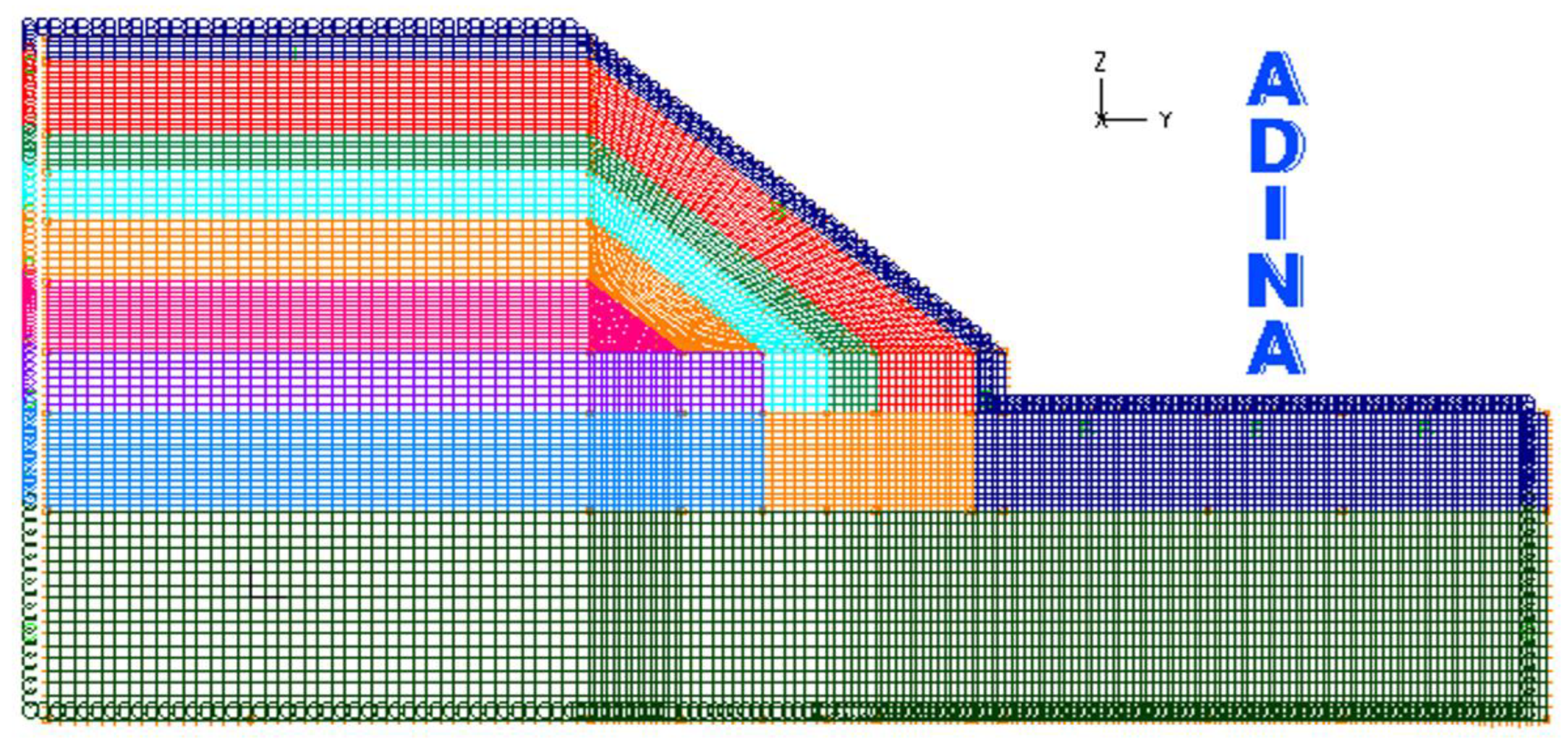

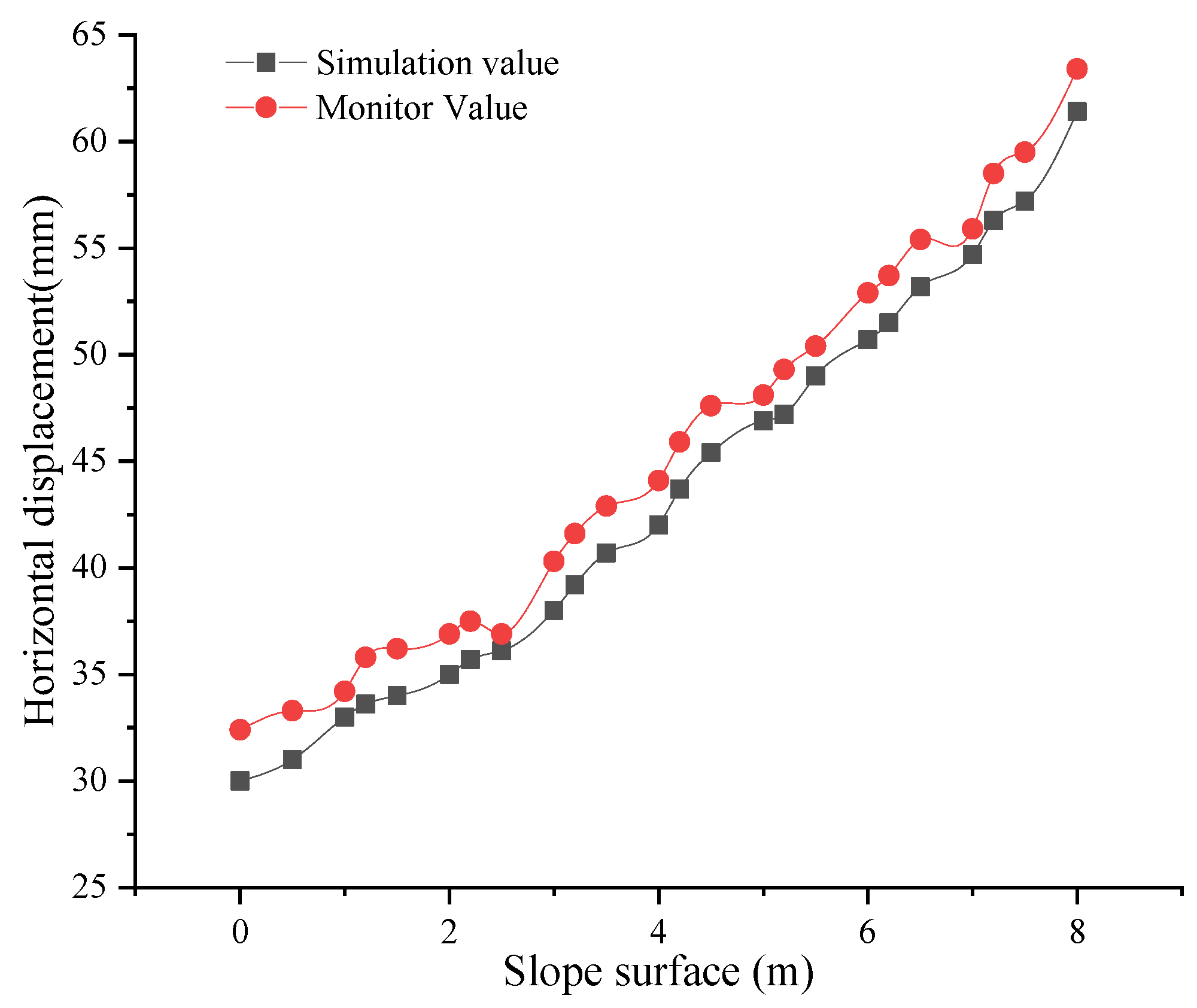
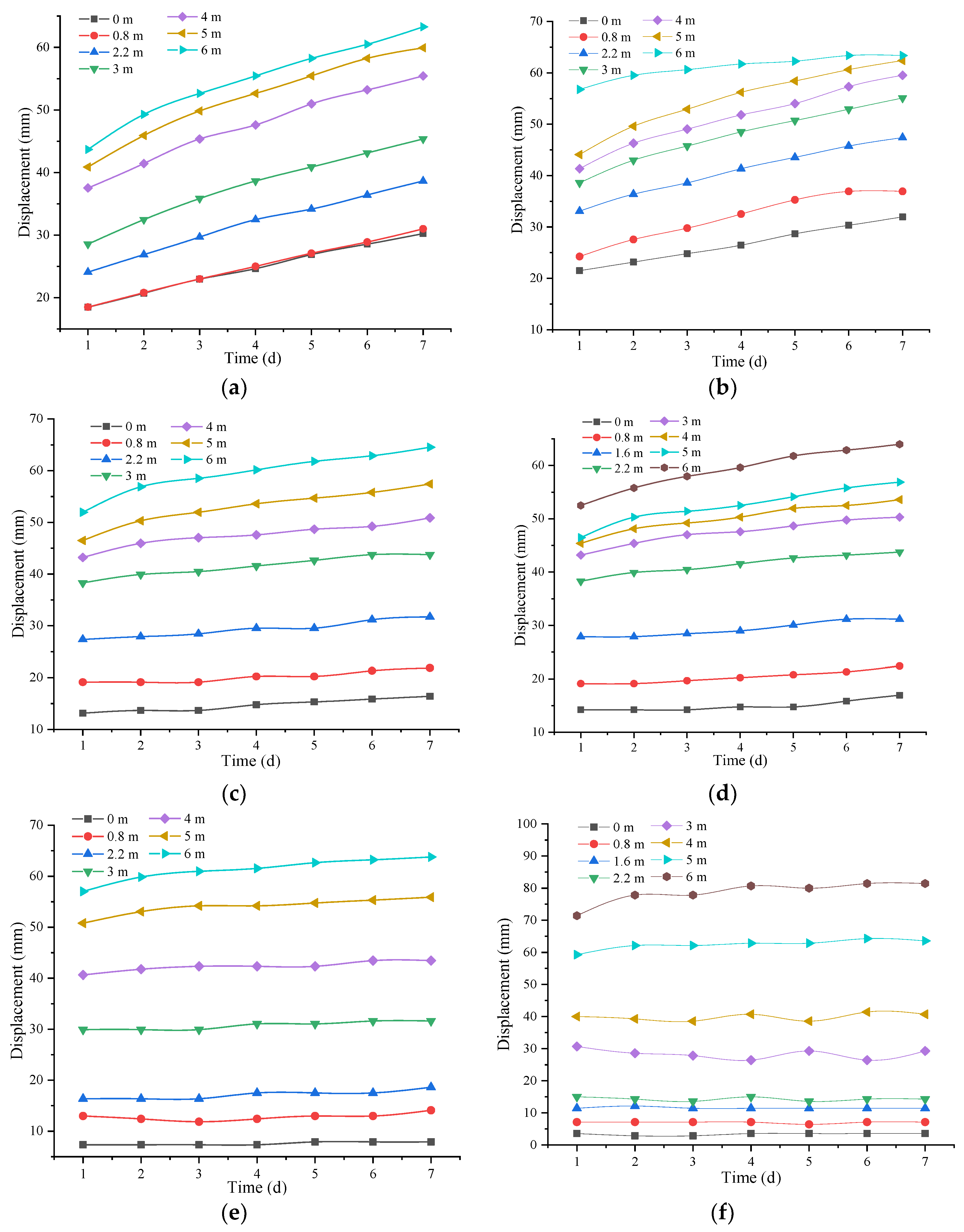
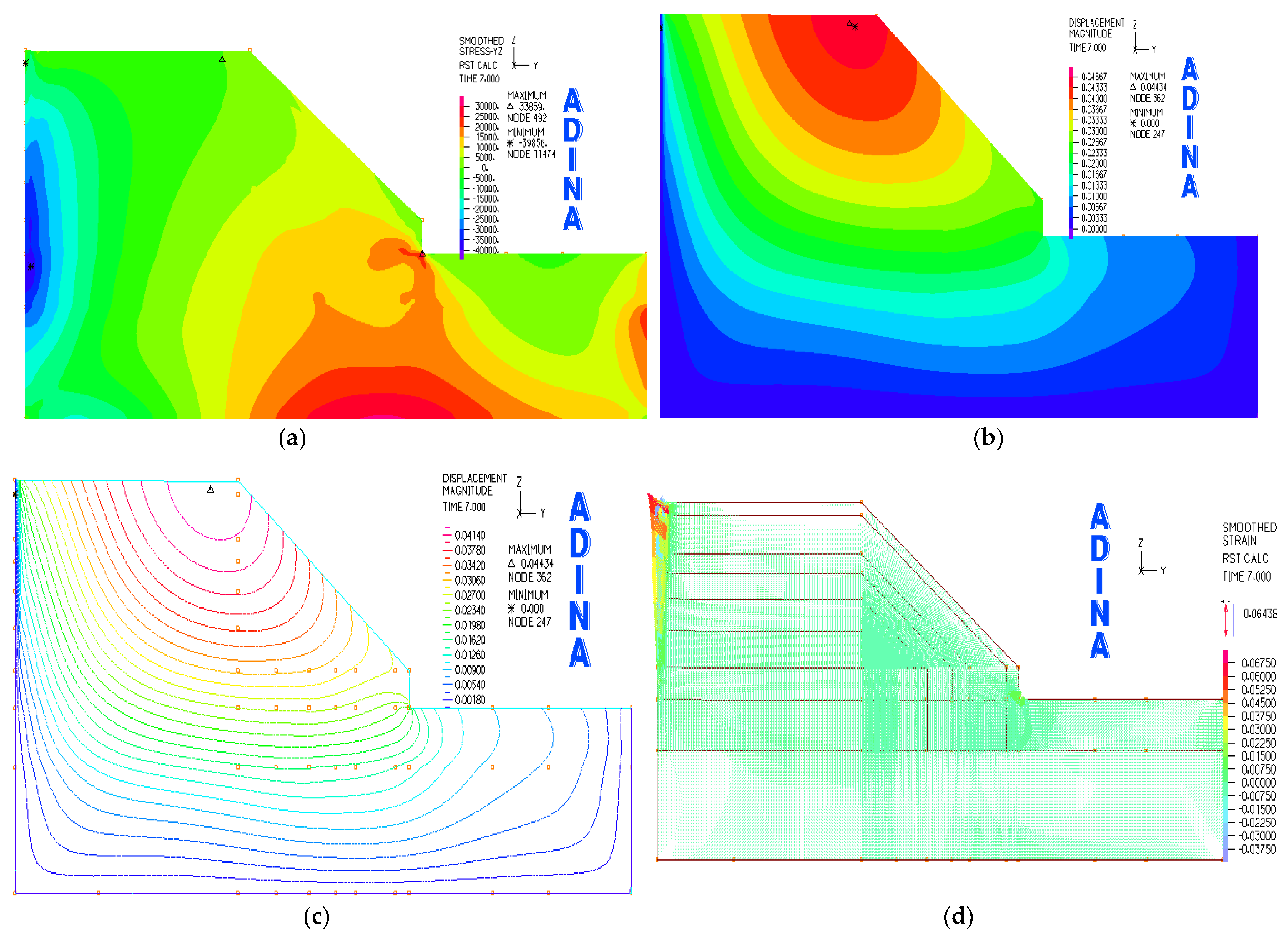
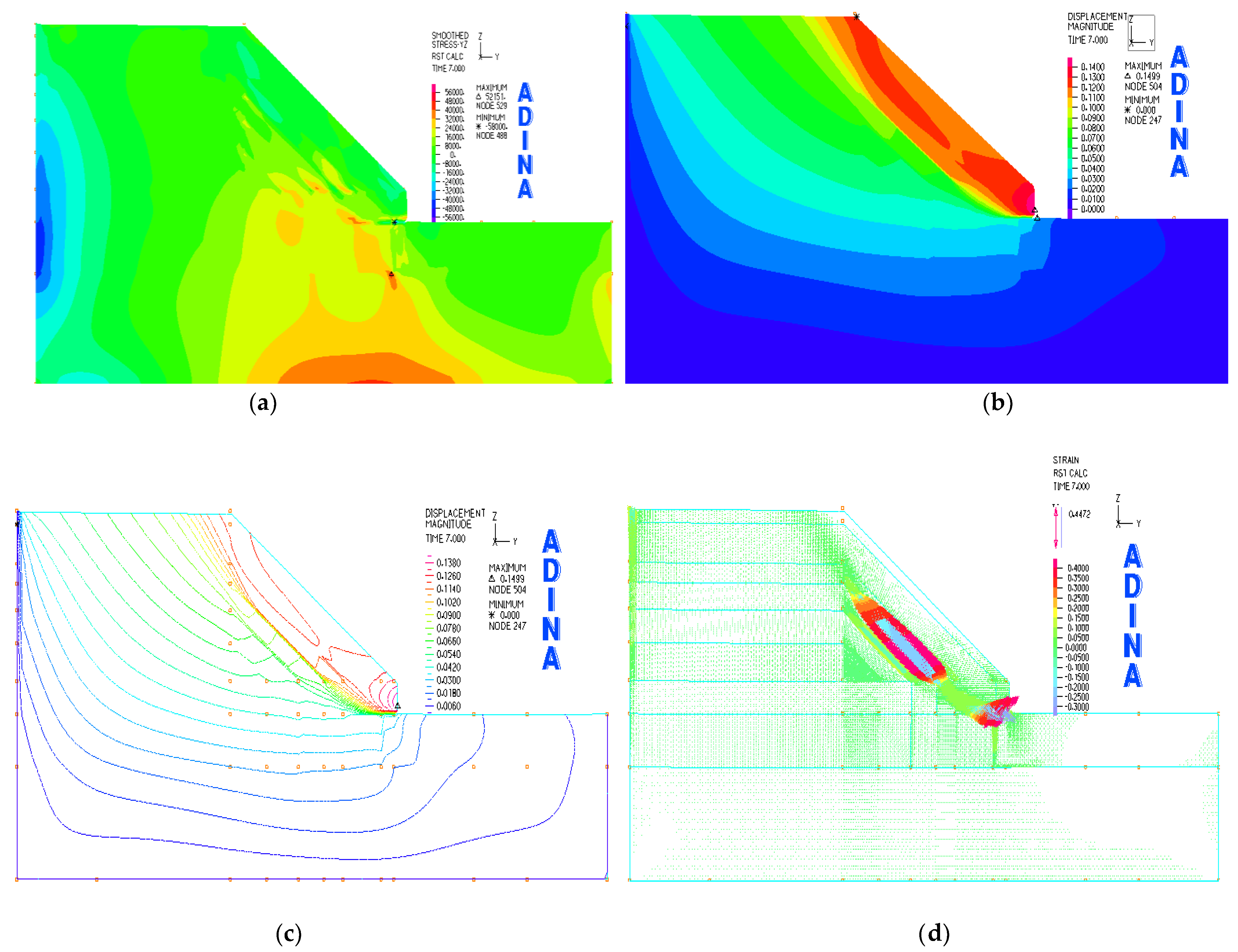

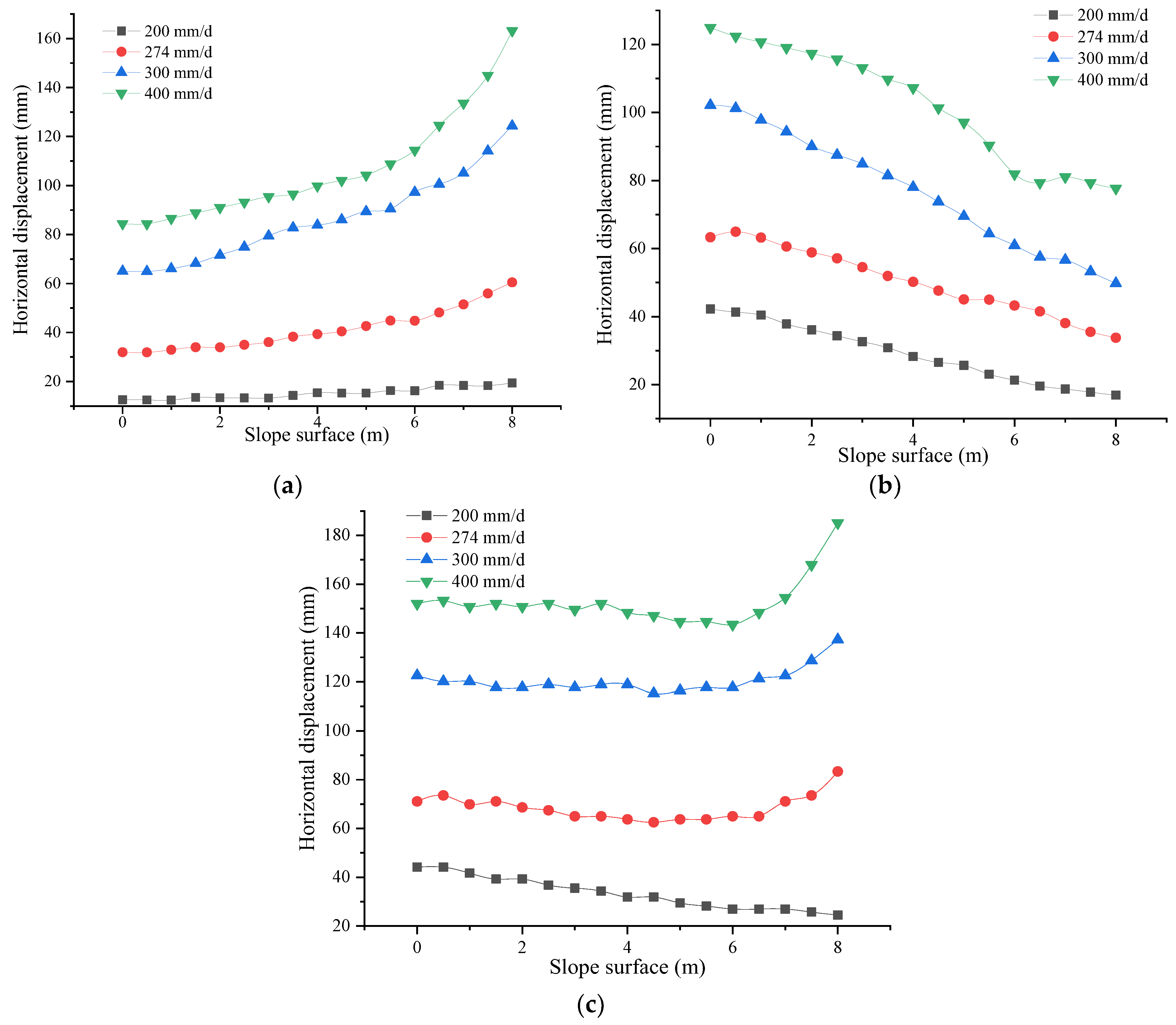
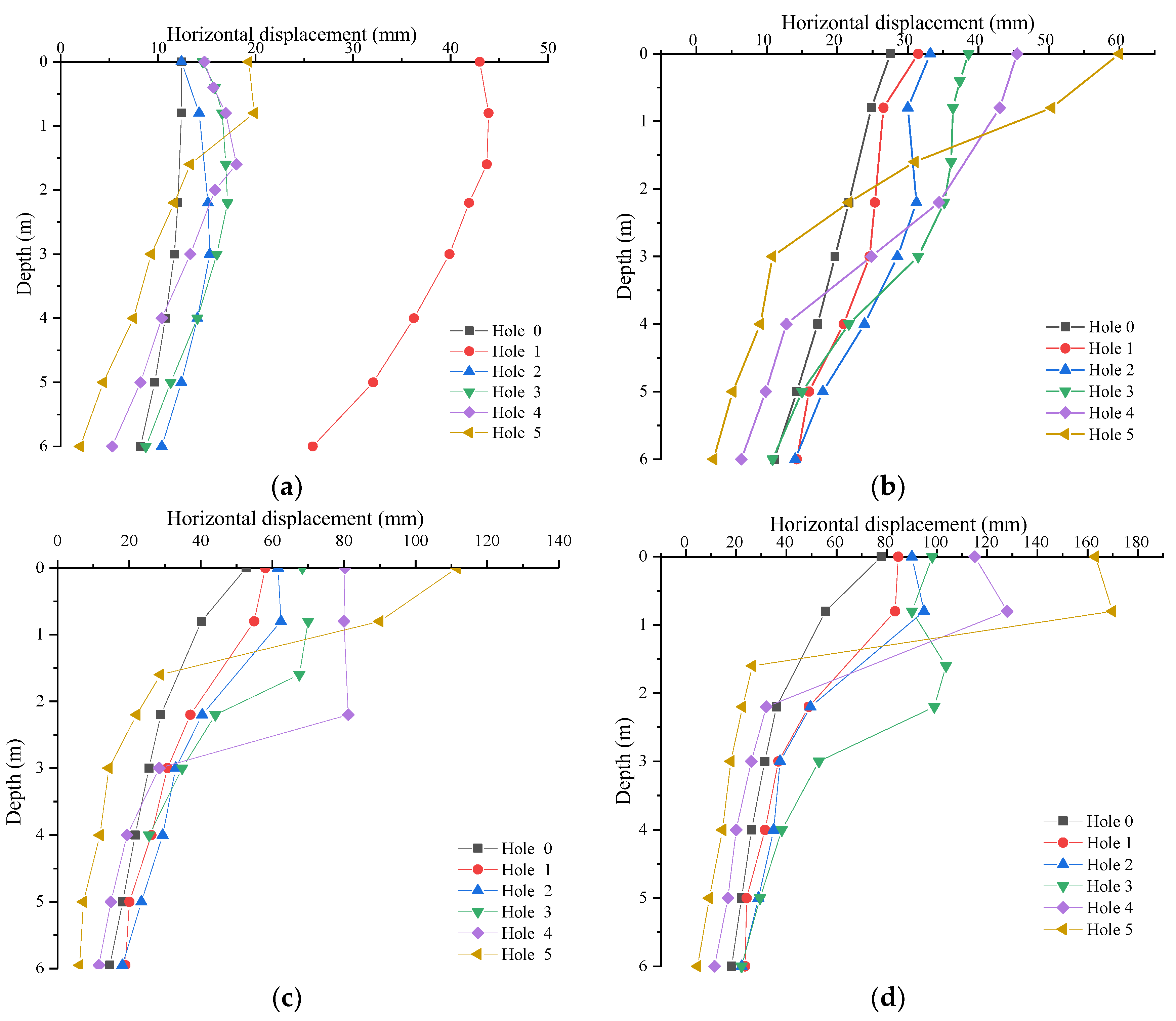
Disclaimer/Publisher’s Note: The statements, opinions and data contained in all publications are solely those of the individual author(s) and contributor(s) and not of MDPI and/or the editor(s). MDPI and/or the editor(s) disclaim responsibility for any injury to people or property resulting from any ideas, methods, instructions or products referred to in the content. |
© 2024 by the authors. Licensee MDPI, Basel, Switzerland. This article is an open access article distributed under the terms and conditions of the Creative Commons Attribution (CC BY) license (https://creativecommons.org/licenses/by/4.0/).
Share and Cite
Zong, J.; Zhang, C.; Liu, L.; Liu, L. Modeling Rainfall Impact on Slope Stability: Computational Insights into Displacement and Stress Dynamics. Water 2024, 16, 554. https://doi.org/10.3390/w16040554
Zong J, Zhang C, Liu L, Liu L. Modeling Rainfall Impact on Slope Stability: Computational Insights into Displacement and Stress Dynamics. Water. 2024; 16(4):554. https://doi.org/10.3390/w16040554
Chicago/Turabian StyleZong, Jingmei, Changjun Zhang, Leifei Liu, and Lulu Liu. 2024. "Modeling Rainfall Impact on Slope Stability: Computational Insights into Displacement and Stress Dynamics" Water 16, no. 4: 554. https://doi.org/10.3390/w16040554
APA StyleZong, J., Zhang, C., Liu, L., & Liu, L. (2024). Modeling Rainfall Impact on Slope Stability: Computational Insights into Displacement and Stress Dynamics. Water, 16(4), 554. https://doi.org/10.3390/w16040554




